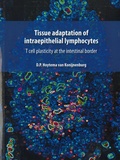Tissue adaptation of intraepithelial lymphocytes
T cell plasticity at the intestinal border
Summary
Adequate adaptation by immune cells to the surrounding milieu is especially important in the intestine, a chronically stimulated barrier tissue where immune cells encounter stimulation from food, the commensal microbiota and potential pathogenic organisms. A main population of uniquely adapted immune cells in the intestine are a type of T cells called intraepithelial lymphocytes (IEL or IET). In this thesis, we first describe the key characteristics of these cells. Next, we investigate the tissue adaptation of intestinal IETs by studying their development and gene expression profiles, behavior and adaptation to anatomical localization as well as their metabolism. Our studies focused both on peripherally induced IELs (especially addressing CD4+ populations, CD4IELs) as well as “natural” TCRgd+ IELs. For CD4IELs, we show that cooperation between the transcription factors T-bet and Runx3 resulted in suppression of conventional CD4+ T helper functions and induction of an intraepithelial lymphocyte (IEL) program that included expression of IEL markers such as CD8aa homodimers. We found that the gut environment provides cues for IEL maturation through the interplay between T-bet and Runx3, allowing tissue-specific adaptation of mature T lymphocytes. In addition, using intravital microscopy and fate mapping experiments, we showed that upon migration to the epithelium, regulatory T cells (Tregs) lose Foxp3 and convert to CD4IELs in a microbiota-dependent fashion. We demonstrate that pTregs and CD4IELs perform complementary roles in the regulation of intestinal inflammation. In studies using human colon tissue samples, we show that the frequency and type of CD4+ T cells in the human colon differs between the intraepithelial (IE) and the lamina propria (LP) compartment. We observed that while CD4+ in the IE follow a surface marker expression pattern of CD8+ tissue resident memory cells (Trm), their transcriptome profile follows a different pattern, with an enrichment for regulatory pathways, suggesting that IE CD4+ T cells may represent a presently unrecognized tissue resident state. We found a complete loss of these IE versus LP differences in T cell composition in patients with active Crohn’s Disease. Additionally, we observed a specific subset of CD69loCD4+ and CD69loCD8ab+cells that is especially increased in the IE and LP at areas of local inflammation. Using high-resolution microscopy techniques and intersectional genetic tools, we investigated the nature of natural IEL responses to luminal microbes. We observed that TCRgd IELs exhibit distinct location and movement patterns in the epithelial compartment that were microbiota dependent and quickly altered upon enteric infections. These infection-induced changes included increased inter-epithelial cell (EC) scanning, anti-microbial gene expression and glycolysis. Both gd IEL behavioral and metabolic changes were dependent on EC pathogen sensing.
In conclusion, this thesis presents evidence of T cell adaptation to the intestinal tissue in terms of gene expression and function, migration, movement behavior and metabolism. These adaptations were influenced by the microbiome and diet, as well as by epithelial cell communication. Interfering with intestinal T cell tissue adaptation led to early invasion by diverse pathogens, inflammation triggered by a dietary antigen, and is associated with inflammatory bowel disease.
